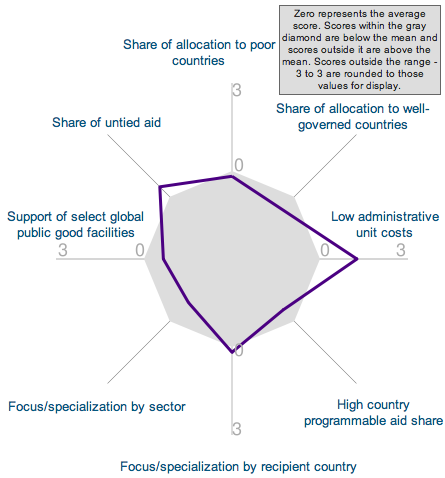
Quality of aid: How does Australia fare?
By Kate Higgins
12 October 2010
A new report, ‘Quality of Official Development Assistance Assessment‘ (QuODA), assesses the quality of aid given by donor countries and aid agencies. It offers an important complement to analyses of the quantity of aid, which dominate aid policy debate. Given that Australia’s aid budget is set to rise to an estimated $8-9 billion by 2015-16, the QuODA report is a welcome addition to the aid analysis toolbox.
The report assesses aid quality using 30 indicators, grouped in four categories that reflect the international consensus of what constitutes high-quality aid. The categories are: (1) maximising efficiency (eg. spending aid in countries where it has the most potential to help); (2) fostering institutions in recipient countries (eg. coordinating spending with local priorities and budgets); (3) reducing the burden on recipients (eg. cutting back on official visits and paperwork); and (4) transparency and learning (eg. sharing useful data on aid spending).
So how does Australia fare?
Australia is the top performer in the transparency and learning category. This is a good result. But Australia’s performance in other categories is not so strong. We rank 14th in the ‘reducing burden’ category, 19th in the ‘fostering institutions’ category and 21st in the ‘maximising efficiency’ category.
A more in-depth read through the (very long) report reveals some other interesting results for Australian aid. Australia is one of the top performers on the ‘low administrative cost’ indicator. This indicator compares donor administrative costs to the total amount of aid made available for programs and projects in partner countries.
Australia is one of the top performers on the ‘share of aid to recipients’ top development priorities’ indicator, demonstrating that Australian aid is guided by the priorities of recipient countries. Australia is also one of the top performers on the ‘fragmentation across donor agencies’ indicator. This is primarily because, in contrast to many other countries where a range of agencies have responsibility for disbursing and delivering aid, Australian aid is delivered through one agency – AusAID.
But it is not all good news. Australia is the worst performer on the ‘contribution to multilaterals’ indicator — just 10% of Australian aid goes through multilateral agencies, based on the 2008 data used in the report. This contradicts information on AusAID’s website, which puts the figure at 30%. Perhaps multilateral contributions have been ramped up over the past two years.
As always with these exercises, the data and methodology will be interrogated and critiqued. This should be encouraged. But the report is a comprehensive contribution to aid analysis and debate, and donors should learn from it. The next step for Australia should be to examine the results in detail, celebrate and build on success, and identify and address areas where there is room for improvement. It’ll be interesting to see when, how and if this happens.
For those wanting more, listen to report authors Nancy Birdsall (President of the Center for Global Development) and Homi Kharas (Deputy Director of the Global Economy and Development program at the Brookings Institution) on the CGD Wonkcast. Also try out QuODA’s online component to explore the data and see how donors compare.
Kate Higgins is a Research Fellow with the Overseas Development Institute, an international development and humanitarian policy think tank. She is based in Sydney.
A version of this article was first published here in the Lowy Interpreter.
About the author/s
Kate Higgins
Kate Higgins is a Research Fellow with the Growth and Equity Programme at the Overseas Development Institute and a Research Associate at the Development Policy Centre.
